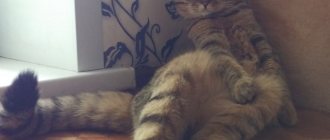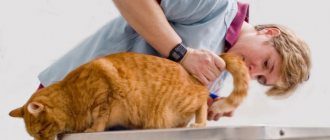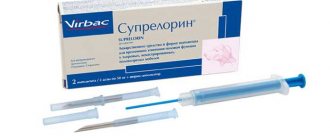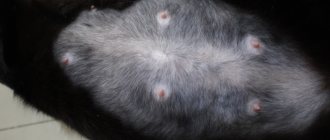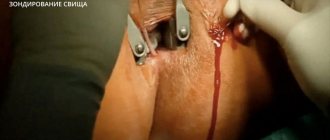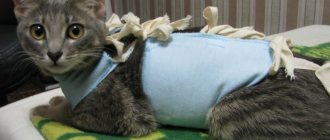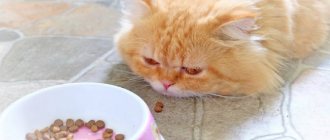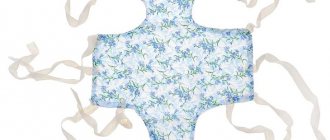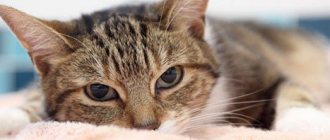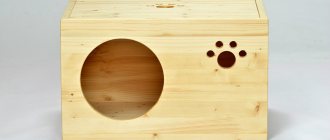The suture during sterilization of cats can be quite large when performing surgery along the white line of the abdomen, small (no more than 1 cm) when sterilizing using the lateral incision method, and practically invisible when sterilizing using laparoscopy. The veterinary specialist who performed the surgery will explain what the stitch should be after sterilizing the cat.
Depending on the chosen surgical technique, the size of the seam will differ. As a rule, sutures are placed when cutting the muscle layers and skin during sterilization along the white line of the abdomen.
This technique is widely used when removing the uterus and ovaries (ovariohysterectomy). When only the ovaries are removed, more gentle techniques are used that do not require a large number of stitches, or are absent altogether (with laparoscopy).
Internal sutures are placed on the muscle layers using self-absorbable suture material, and external sutures are sutured with surgical threads, which must later be removed.
Depending on what kind of suture the cat has after sterilization, the rate of tissue regeneration will depend. It is important to note that during the entire postoperative period the suture should remain clean and as dry as possible.
If any pathological changes are detected - suppuration, inflammatory processes or bloody discharge, you must contact a veterinary clinic in order to avoid serious complications.
How many days after surgery should stitches be removed?
It all depends on the specific case. The condition of the postoperative wound plays a huge role.
By the time the suture material is removed, it must meet the following requirements:
- The cut line may be rough, the stitches of the sutures are clearly visible, but the presence of bloody discharge, blood crusts or exudate is unacceptable.
- You need to feel the seam. If everything is in order and the suture material can be removed, then the local temperature will be normal.
- Swelling and redness of the postoperative wound are also unacceptable.
As a rule, the suture reaches this state by the tenth day after surgery, in some cases you have to wait two or three weeks (this does not happen often).
How many days after endoscopic surgery can the suture be removed? The suture is rarely longer than five millimeters; there is no need to rush to remove it. Haste can leave the animal's abdominal cavity open to bacterial contamination.
Care plan: first week day by day
After sterilization, doctors give a list of recommendations for caring for your pet.
Requirements depend on the time that has passed since the operation:
- 1st day. The cat comes out of anesthetized sleep for several hours. During this period, she is in an inadequate state: she tries to crawl away, shows aggression, and meows. It is necessary to limit the movement of your pet until coordination is restored. To eliminate pain, give an injection prescribed by a veterinarian. No feeding, only water.
- 2nd day. The animal is in pain and shows aggression or tries to hide. At this time, the pet makes its first attempts to lick the seam. You need to give painkillers or give an injection. You can start feeding in small portions.
- 3rd day. The condition is improving and there is almost no pain. The animal becomes active, asks for food, goes to the litter box. You should measure the temperature and if it increases or decreases, consult your veterinarian.
- 4th day. The pet eats and goes to the tray on its own. Despite the appearance of an appetite, it is impossible to overfeed a cat - after sterilization, animals tend to become obese.
- 5th day. The stitch is showing signs of scarring and is not painful. The cat can be allowed to walk around the apartment and jump on low surfaces.
- 6th day. No pain. The animal is active, eats well and goes to the tray.
- 7th day. The stitches are removed.
If the rehabilitation plan is followed, the pet will quickly recover after sterilization.
Do I need to remove stitches at all?
Here everything depends on the characteristics of the suture material used during the operation. Today, veterinarians all over the world are trying to use varieties that dissolve on their own. But this doesn't always happen.
In addition, even material that is “digested” by the animal’s body is not immediately absorbed. The stitches left on the animal's skin are disturbing and irritating. Therefore, the cat will constantly itch and chew its belly. All this may well lead to the development of an inflammatory reaction.
Many veterinary specialists clearly answer that sutures should be removed regardless of the suture material used.
This will save you from many problems in the future. Please note that this only applies to external seams. Sutures placed on the peritoneum dissolve perfectly.
Nutrition
The doctor will tell you how long after surgery you can feed your cat. The period depends on the type of anesthesia used. Some medications allow eating as early as six hours after the procedure. Some anesthesia requires a 12-hour fast. It all depends on whether the drug affects the swallowing reflex.
If the cat was wearing a special collar, it is necessary to use a bowl smaller than the diameter of the device for feeding. It is best to place the bowl on a slight elevation to make it easier for your pet to reach the food.
If your pet shows an appetite, you can start feeding him. At first, you need to give food in small portions, after crushing it and soaking it in water. Preference should be given to attractive foods, as well as those lines that have a higher calorie content, so that a weakened animal receives maximum energy from a small amount of food.
Is it possible to remove stitches at home?
Yes, this is quite possible. Moreover, it is at home that sutures are usually removed. As a rule, there is no need to take the cat to the clinic for this procedure, since all the necessary manipulations can be performed independently without any problems.
Moreover, if your pet has a choleric type of character (i.e., is overly nervous), then you shouldn’t bother her with a trip to the clinic.
For everything to go well, you need to prepare the following things:
- A stable and fairly stable table with a flat surface.
- Oilcloth and several diapers.
- Sharp nail scissors and tweezers.
- Alcohol tincture of iodine or brilliant green.
Most likely, everything you need can be found in any home without any problems; no special devices are required for removing sutures.
Preparing to remove sutures
First you need to assess the “mental state” of your pet. If for some reason the cat shows nervousness or aggression, then it is better to wait until the stitches are removed or consult a veterinarian.
Perhaps a specialist will be able to recommend some mild sedatives that have a calming effect. With their help, it will be much easier to remove stitches even in an easily excitable and aggressive cat.
Preparation is carried out as follows:
- First you need to take care of good lighting. Working in semi-darkness is not a good idea. It is advisable that the lighting be from above: in this case there will be fewer shadows and the task of removing seams will be easier.
- If the cat is a representative of long-haired breeds, it is necessary to trim off the excess fur covering the seam line. The less hair there is, the less likely it is that hairs will get into the wrong place.
- At the same time, boil the scissors and tweezers that will be used to remove the suture material thoroughly (for at least half an hour). If it is impossible to boil the instruments for some reason, you should at least wash them with warm water and soap (or wipe them thoroughly with medical alcohol).
- After this, wipe the seam line with warm soapy water. This is necessary to remove dirt and pieces of fur from the animal’s skin. In addition, after treatment the seams will soften somewhat, making them much easier to remove.
Anesthesia
Sterilization of cats involves surgery, which is performed under anesthesia. Before administering anesthesia, the doctor performs so-called premedication. What does this procedure mean:
- The animal is given drugs that reduce muscle tone;
- To avoid an allergic reaction, antihistamines are administered;
- The cat is also given substances that prevent excessive production of saliva and phlegm;
- If necessary, pressure stabilization is carried out. Drugs that increase vascular tone are also administered.
All drugs, including anesthesia itself, are administered either intramuscularly or intravenously. The method is determined by the veterinarian.
Intramuscular anesthesia is used more often because it is cheaper and easier to use. The disadvantage of this method can be considered the long awakening of the animal after this type of “sleep”.
Intravenous anesthesia is a more expensive method, however, it has more advantages. The method is more manageable. If necessary, the doctor adjusts the amount of the substance during surgery. After such anesthesia, cats wake up faster and recover more easily. The method has fewer side effects and complications.
Step-by-step instructions for removing sutures
Here are step-by-step instructions that must be strictly followed when removing suture material:
- Before starting work, you need to wait about ten minutes so that the soapy water, which we already talked about above, has time to soften the suture material.
- After this, you must definitely count how many stitches were placed. If possible, you should also call the veterinarian who performed the spay and ask how many stitches he used. This is necessary so as not to accidentally leave a couple of stitches. This, by the way, does not happen so rarely.
- You can start withdrawing. First, you need to thoroughly wipe the tweezers with alcohol, and then carefully grab the seam loop. It should be pulled upward as much as possible.
- As soon as the seam has stretched sufficiently, you need to insert the lower jaw of the scissors under it and cut the thread.
- To remove the remainder of the latter, you need to pull it out of the skin. This is done carefully and without unnecessary haste. If the thread is “stuck” to the skin, it is necessary to carefully turn it around its axis and pull the rest of the seam towards you. If you pull too hard, you can injure your cat, tearing the thin layer of newly healed skin.
If the seam does not give way, and a piece of thread comes out of the skin with great difficulty, there is no need to rush and tear it out “forcibly”. You can wipe the grout line again with warm soapy water and wait about an hour. After this period, the skin will soften, after which everything can be done without much effort.
Medicinal support
All medications must be approved by a veterinarian!
Painkillers:
- Rimadyl (carprofen) – intravenously or subcutaneously at a dose of 4 mg/kg (equivalent to 1 ml/12.5 kg of weight) once a day;
- Tolfedine (tolfenamic acid) – 4 mg/kg once a day orally with food;
- Ketofen 1% (ketoprofen) – subcutaneously, intramuscularly or intravenously at a dose of 2 mg/kg (or 0.2 ml/kg) once a day and no longer than 3-4 days;
- Loxicom (meloxicam) – 0.1 mg suspension/kg orally on the first day once, 0.05 mg/kg on subsequent days.
Seam treatment products:
- Chlorhexidine 0.05% (aqueous solution) - water the seam through a dispenser or drip from above using a pipette until healing;
- Dioxidine 0.5% - use similarly to Chlohexidine;
- Veteritsin spray - spray the suture area 1-2 times a day before removal;
- Aluminum spray - spray on the seam every few days until healing;
- Chemi spray - treat the seam once a day until healing;
- Levomekol ointment - apply around the wound once a day, under a bandage.
Antibiotics:
- Sinulox (amoxicillin + clavulanic acid) – intramuscularly once a day at a dose of 0.5 ml/10 kg for 3-5 days;
- Amoxicillin 15% – subcutaneously or intramuscularly 1 ml/kg (in terms of 15 mg/kg) once for 5 days.
General strengthening drugs:
- Gamavit - the first 2-3 days at a dose of 0.5 ml/kg of body weight, then up to two weeks at a dose of 0.1 mg/kg.
Hemostatic agents:
- Travmatin - intramuscularly or subcutaneously 0.5-1 ml 2-5 times a day;
- Etamsylate – 0.1 ml/kg twice a day.
Safety rules when removing sutures
In order not to endanger the life and health of the cat, the owner who decides to remove the stitches himself must strictly follow the safety rules below:
- It is not recommended to remove stitches unless they have been examined by a veterinarian first . Only an experienced specialist will be able to tell how well the postoperative wound has healed and how safe it will be to remove the suture material.
- It is forbidden to remove sutures if the suture line is “inflated” , inflamed, numerous areas of redness are observed, and the local temperature in these places is significantly increased. These signs indicate a strong inflammatory response. In such cases, you should call your veterinarian immediately.
- In cases where there is bleeding (even a drop), or the release of exudate (regardless of the volume of the latter), the sutures are also prohibited from being removed.
Remember! Even if none of the above is observed, but the cat is behaving strangely and nervously, it is better to have it examined by a veterinarian first.
What is the approximate cost of the operation in different regions of the country?
The cost of the operation depends on many factors: the cat’s health condition (does it require additional tests, globulin administration, etc.), the veterinarian’s qualification level, the services provided by the clinic (transporting the animal, vaccinating it, and much more). The average price in Ukraine is from 450 to 1000 UAH, in Russia - from 2000 to 8000 rubles.
In the capitals, the cost may be somewhat inflated - for example, in Kyiv, private clinics provide such a service for 600 UAH or more, the price in Moscow is from 2,500 rubles and more. Too low a price should alert you, because it includes not only the veterinarian’s fee, but also the cost of dressings, anesthesia and other drugs.
Safety precautions for the pet owner
During the procedure, the owner should worry not only about the safety of his pet. The health of the person undergoing the suture removal procedure may also be at risk. This is due to the fact that cats are rarely delighted with the fact that someone is “poking” their skin with tongs.
As a rule, removing stitches is not the most pleasant procedure; severe discomfort is possible. To minimize the likelihood that your pet will tear your hands until they bleed, you need to take the following steps:
If possible, call your veterinarian. The specialist may recommend some mild sedatives. Under their influence, the animal will become calmer, and therefore it will be easier for the owner to cope with it.
Please note that cat sterilization itself can be carried out using the same medications. If you reintroduce them a few days after the operation, the animal’s body will have a very hard time (the so-called cumulative effect will play a role). Thus, in this case it is necessary to select other sedatives. This will avoid unpleasant consequences.
However, you can cope without “chemistry”, but this will require an assistant. Just remember that you will have to hold the animal quite firmly.
Estrus, pregnancy and childbirth
Not all owners understand the relationship between the reproductive and reproductive systems. Because of this, it is completely unclear when to spay a cat: before, during or after heat. Even more difficulties arise with the need for childbirth. Many owners mistakenly believe that deprivation of reproductive function is safe only after bearing at least one litter.
Surgery during pregnancy
Surgery is permissible if the pregnancy is no more than 1 month. Otherwise, there is a possibility of increased blood loss and a prolonged postoperative period. Intervention is also permissible in case of abnormal fetal development, poor health or old age, which prevents the safe bearing of kittens. In all other cases, the operation is postponed until complete postpartum recovery.
Surgery after childbirth
After giving birth, a young mother needs 2-3 months to fully recover. During this time, the uterus returns to its original size, and blood circulation in the pelvis is normalized.
Emergency intervention immediately after the birth of kittens is practiced when:
- detection of tumors in the reproductive organs;
- the presence and high probability of postpartum hemorrhage;
- uterine rupture;
- damage or abnormalities of the placenta.
In these situations, the risk of possible complications is higher than the risks associated with sterilization. The procedure is considered justified.
Is it necessary for a cat to give birth at least once before sterilization?
The most popular question arising from the baseless myth about the “joy of motherhood.” From a psychological point of view, animals are not subject to emotions and act instinctively. The absence or presence of pregnancy is taken for granted by them, and therefore does not have a fundamental impact on their lives.
An obvious logic appears when considering the issue from a biological point of view. Before pregnancy, female sex hormones (estrogens), responsible for sexual desire, are produced by the ovaries. If they are removed in a timely manner, the animal loses not only the ability to conceive, but also interest in the opposite sex. Otherwise, other internal secretion organs are involved in the production of estrogen. As a result, the operated pet will not be able to become pregnant again, but will continue its loud rituals of calling cats. If you do not want to endure such concerts for the rest of your furry pet’s life, do not allow mating until sterilization.
In addition to the high risk of retaining some sex hormones, pregnancy reduces the effect of the procedure. The probability of developing cancer after the first birth is 8%, and after the second it increases by more than 3 times.
Is it possible to operate on a cat during heat?
During estrus, hormonal changes occur. Any intervention is fraught with multiple complications, including the development of oncology. Due to the dilation of blood vessels, there is a high probability of heavy blood loss. Animals recover from anesthesia worse and have a more difficult time experiencing the postoperative period.
It is safer to carry out surgery 2 weeks before or after estrus, when the pet’s condition returns to normal. Exceptions include prolonged heats with a short interval between them. They impair quality of life and lead to exhaustion. In this case, the animal is sterilized for medicinal purposes.
What to do if the cat removed the stitches on its own?
The situation when the cat removed the stitches itself is not uncommon in veterinary practice. Unfortunately, nothing good should be expected from such initiative, but there is still a chance for a successful outcome. They increase if the animal has its stitches removed closer to the date of their “official” removal.
If this happened in the first days after the operation, then the owner does not have much choice: he needs to urgently call the veterinarian.
The following signs indicate a high probability of severe complications:
- Heavy bleeding.
- Torn, torn edges of a postoperative wound.
- Easily visible internal organs visible through the disturbed wound channel.
Let us repeat once again - in such cases you need to immediately call a veterinarian. If the bleeding is severe, it is necessary to take the cat to the nearest clinic, but we would recommend waiting for a specialist at home. Transporting a cat with such injuries is very dangerous, and the pet may simply not survive until medical attention is provided.
General recommendations
Blanket (bandage)
After sterilization, the abdomen must be covered with a special bandage. The bandage is worn all the time: from the end of the operation to the removal of sutures. It is advisable not to remove the bandage for a couple of days so that the cat does not lick the small wounds from the stitches.
The blanket is usually made of natural cotton fabric and does not cause physical discomfort to the animal after surgery. But due to the peculiarities of tactile sensitivity, the cat may be lazy to walk in it or have a strange gait. When the bandage is removed, everything falls into place.
You need to be careful that the cat does not cling to anything with the blanket and does not get stuck anywhere.
Bandage for cats
Eyes
If the cat is handed over to the owners after the operation in a state of anesthesia, then the process of blinking for the pet falls on them. Cats under anesthesia often have their eyes open. To prevent the cornea from drying out, you need to periodically cover your eyes (blink) or drip artificial tears or 0.9% saline solution onto their surface.
General condition of the house
Upon arrival home, the cat should be placed warmly (for example, on a warm heating pad) and on soft bedding, because After anesthesia, the process of thermoregulation is disrupted. It is important to ensure that the cat does not fall from a height, so it is best to place it on the floor. It is necessary to lay down a well-absorbent diaper, because... Until recovery from anesthesia, the cat cannot control the physiological needs to empty the bladder and rectum. There may be trembling throughout the body (general tremor) or vomiting.
Place the cat on its right side.
At first, the cat should not actively play, jump, or climb on pieces of furniture.
- On the first day after surgery, the cat must definitely go to the toilet - this is mandatory after anesthesia.
- For the first two days, you may need pain relief. You need to monitor your behavior. Signs of pain: meowing, dilated pupils, apathy.
- Antibiotic therapy is not required if the operation is planned and carried out taking into account the rules of asepsis and antisepsis.
- Vitamin preparations and restoratives are prescribed only to old and weak cats who have undergone a difficult operation and are discussed with the doctor in advance.
- In case of urgent need (the suture is bleeding or internal bleeding has been detected), hemostatic therapy may be prescribed.
Coming out of anesthesia
Three types of anesthesia are usually used. After each type of anesthesia, the cat comes to its senses differently.
- Muscle relaxants + analgesics. The most effective mixture, used most often. The main disadvantage is the difficult recovery from such anesthesia: from 5-6 hours to a day.
- Muscle relaxant + epidural anesthesia. The mixture is slightly toxic, the cat easily tolerates it and quickly recovers from such anesthesia (up to 8 hours maximum). But there is a high probability of complications if the injection into the epidural space is carried out incorrectly - full sensitivity and motor activity in the hind limbs can return up to 2 days. When performing such anesthesia, the qualifications and experience of the surgeon are very important.
- Gas (inhalation) anesthesia. A very effective and minimally toxic method, but it is rarely used due to the lack of special equipment and mixtures of substances for anesthesia. The cat comes to its senses almost immediately as soon as the anesthesia machine is turned off.
When recovering from anesthesia, the cat will be out of control for some time, coordination will be impaired, and the cat’s behavior after sterilization may seem inadequate. There are attempts to get up, run somewhere, perhaps meowing, and an obvious lack of understanding of what is happening around. It is important not to let the animal hide in the far dark corner, so that there are no difficulties in removing it. For some time, the cat may not respond to the name, walk slowly, unsteadily and unsteadily. The main thing is that the pet is visible all the time for the first day!
Food and drink
On the day of the operation, the cat does not need to be fed, only watered. If you can’t do it yourself, it’s better to do it through a syringe in a small portion.
Start feeding from the second day with a volume less than the usual portion, approximately 1/3. The cat should drink on its own. Food should be easily digestible and low-fat.
There are cases that a cat does not eat after sterilization for 2-3 days, but only drinks. This can also happen, the main thing is to observe her behavior. If it is not associated with other symptoms, it’s okay.
Processing and removal of seams
Throughout the entire postoperative period, the suture should be clean and dry. Any suppuration, inflammation or bloody wetting is a reason to contact a veterinarian.
Depending on the type of operation, the stitches may be on the abdomen along the linea alba, on the side, or in the form of punctures if the operation was performed using a laparoscope.
Sutures are placed on the muscle layer and on the skin (if on the stomach) or only on the skin (with an incision on the side, the muscles are not cut, but moved apart, and during laparoscopy small punctures are made). Internal sutures are applied with self-absorbing threads, external sutures are applied with surgical thread (it must be removed over time).
Until the stitches are removed, the wound is treated daily with any antiseptic solution, but without alcohol, so as not to cause skin burns. If the veterinarian said that the seam does not need to be processed, eliminate any possibility of contamination of the seam.
On days 7-10, the sutures are removed or dissolved, depending on what kind of thread was used by the veterinarian; he also discusses this after the operation.
